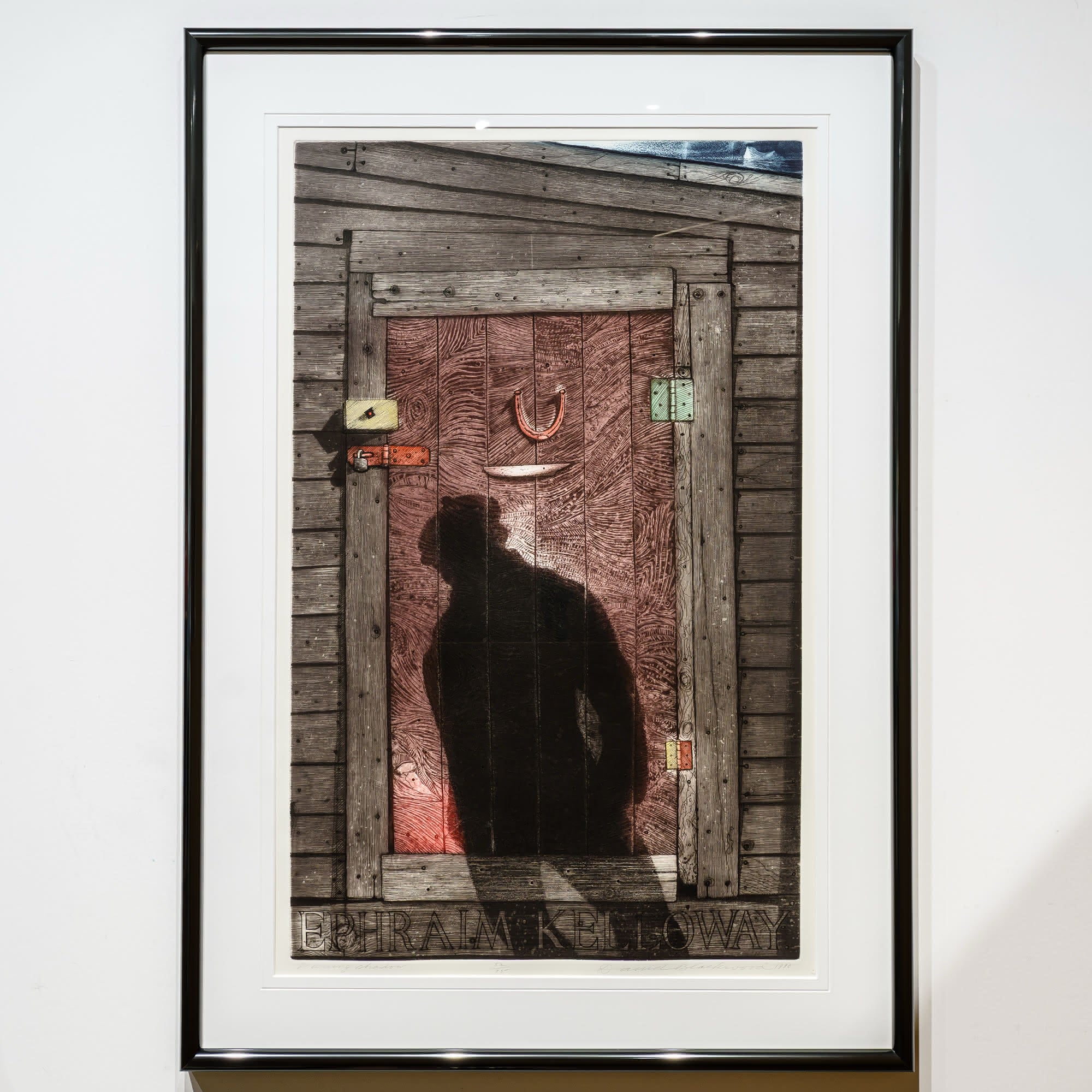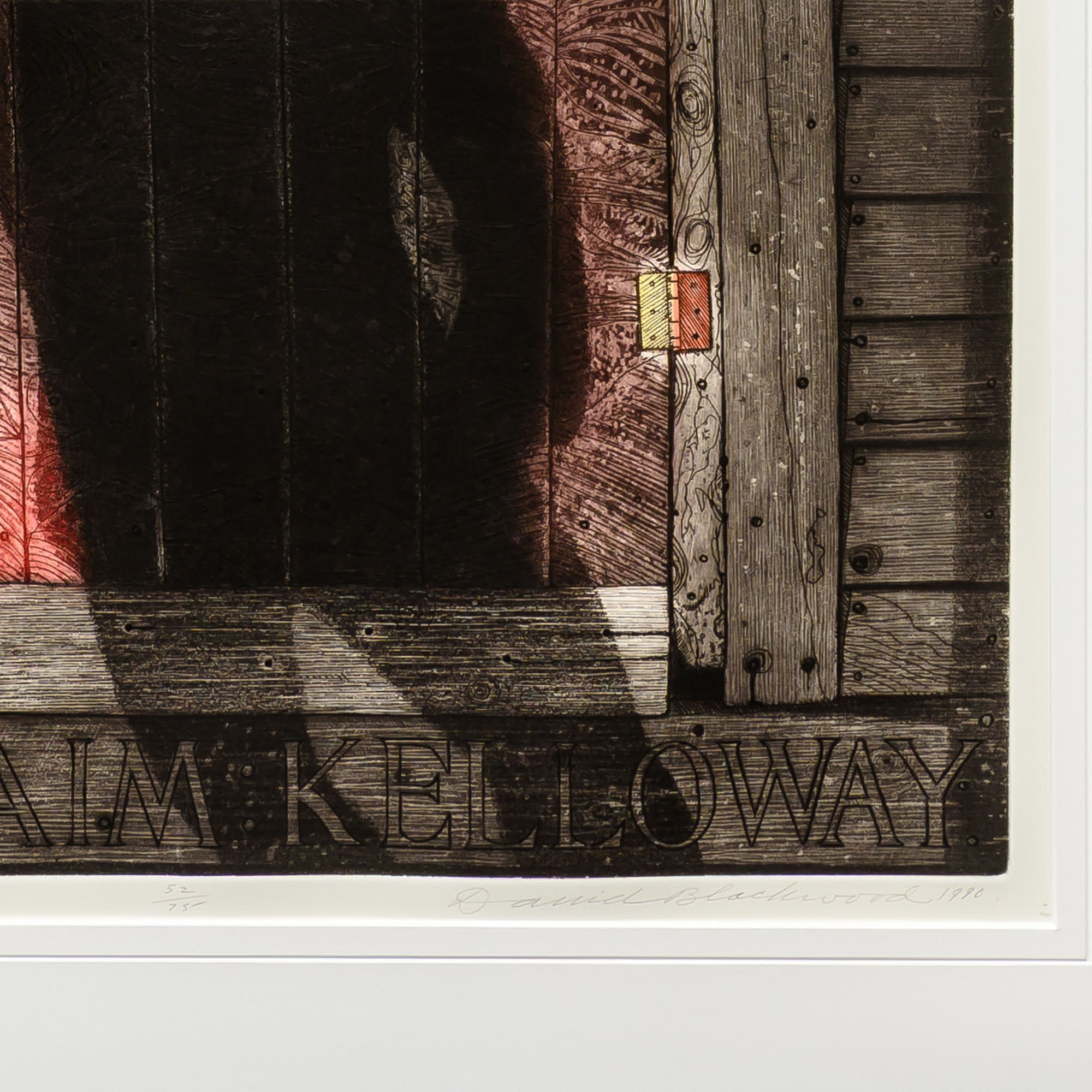


Passing Shadow | Etching 52 of 75
We believe in transparency. Review our Terms of Service, Return Policy, and Shipping Policy. Have questions? Contact us or call 780.488.4892 or 855.488.5892.
Pickup available at Edmonton
Usually ready in 24 hours

Passing Shadow | Etching 52 of 75
Edmonton
10337 124 Street
Edmonton AB T5N 1R1
Canada
About the Artwork
Passing Shadow (31.75" × 19.75", 1990) is an etching and aquatint by David Blackwood (1941–2022) that returns to one of his earliest and most enduring memories from Wesleyville, Newfoundland — the legendary painted door of his neighbour, Ephraim Kelloway. The weathered door stands framed by grey clapboard, its deep burgundy planks marked by a copper horseshoe, tarnished hinges, and the silhouette of a figure stretching across its surface. Blackwood's aquatint technique renders remarkable texture, from the grain of the weathered siding to the faint gleam of metal hardware.
The brothers Alpheus, Jacob, and Ephraim Kelloway were Blackwood's next-door neighbours in childhood. In a 1990 artist statement, Blackwood recalled how "for several summers in the mid-fifties, Ephraim Kelloway painted his barn door — some say fifty times," layering it in black, yellow, red, blue, silver, and pink, then embellishing it with "a variety of hinges, a horseshoe, a half-model of a boat and cutouts of brightly coloured and lettered tin." The final result was, in the artist's words, "a richly painted and decorated icon."1 This subject first appeared in Ephraim Kelloway's Door (1981) and returns here seen through reflection and time. The shadow across the surface suggests the enduring presence of memory itself — the neighbour, the artist, or the passing image of all who move through memory's threshold.
Subtle tones of green and copper echo the decorative details Kelloway once added, while light appears to emanate from the lower edge — a signature quality in Blackwood's work where illumination comes from within rather than without. More than a portrait of a door, this print stands as a document of craft, community, and the quiet perseverance of outport life in mid-century Newfoundland.
Dimensions and Details
- Title: Passing Shadow
- Artist: David Blackwood (1941–2022)
- Year: 1990
- Size: 31.75" × 19.75" (80.6 × 50.2 cm)
- Medium: Etching and aquatint on paper
- Edition: 52/75
- Condition: Professionally framed and ready to hang; signed and numbered by the artist
Exceptional Archival Documentation
This work is directly connected to a 1990 letter written by David Blackwood, in which the artist reflected on his neighbours Alpheus, Jacob, and Ephraim Kelloway and the many summers Ephraim spent repainting his barn door. That correspondence — held in the West End Gallery archives — records the story of the door's transformation "some say fifty times" in colour and decoration, inspiring both Ephraim Kelloway's Door (1981) and Passing Shadow (1990). Together, these prints form a personal narrative cycle rooted in the artist's own childhood in Wesleyville.
Acquisition Enquiries
Passing Shadow is offered exclusively through West End Gallery. Serious acquisition enquiries are welcome. We invite you to contact us directly to arrange a private viewing. Layaway options are available upon request. Shipping is quoted based on location; local delivery within Edmonton and surrounding communities is complimentary.
Citations
- David Blackwood, artist's statement for Station Art Gallery 20th Anniversary Exhibition, 1990. West End Gallery Archive: David Blackwood Letters and Notes, Page 22.
Accessibility Description
The artwork shows a vertical wooden door framed by weathered grey clapboard siding. The central door planks are a rich reddish-brown burgundy, with visible wood grain and vertical board construction. Near the top hangs a small copper-coloured horseshoe. Below it sits a pale metal latch and crossbar. Patched hinges in shades of copper, verdigris green, and tarnished brass mark the door's left edge.
A dark silhouette of a human figure, seen in profile, stretches across the door's centre panel. The shadow is crisp and well-defined against the textured wooden surface. Light appears to glow faintly near the lower edge of the door, suggesting illumination from within. The framing timbers surrounding the door are rough and worn, with visible knots, grain, and surface scratches characteristic of weathered wood exposed to maritime conditions.
Beneath the image, the name "Ephraim Kelloway" appears inscribed along the base margin. The work is an etching and aquatint measuring 31.75 inches high by 19.75 inches wide (80.6 × 50.2 cm).
Full Provenance
- 1990: Created by David Blackwood
- 1990–Present: Private collection; offered through West End Gallery, Edmonton
Disclaimer
This description has been prepared by West End Gallery using original documentation and current scholarship. Whilst every effort has been made to ensure accuracy, minor variations or additional information may emerge through ongoing research. Prospective purchasers are encouraged to contact us to confirm any details critical to their acquisition decision.
Choose options



